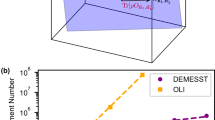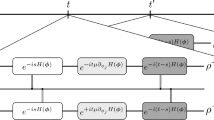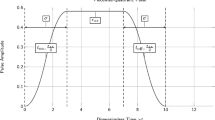Abstract
We investigate the quantum parameter estimation in circuit quantum electrodynamics via dispersive measurement. Based on the Metropolis–Hastings algorithm and the Markov chain Monte Carlo (MCMC) integration, a new algorithm is proposed to calculate the Fisher information by the stochastic master equation. The Fisher information is expressed in the form of log-likelihood functions and further approximated by the MCMC integration. Numerical results show that the evolution of the Fisher information can approach the quantum Fisher information in a short time interval. These results demonstrate the effectiveness of the proposed algorithm. Finally, based on the proposed algorithm, we consider the effects of the measurement operator and the measurement efficiency on the Fisher information.





Similar content being viewed by others
Explore related subjects
Discover the latest articles, news and stories from top researchers in related subjects.References
Helstrom, C.W.: Quantum Detection and Estimation Theory, Mathematics in Science and Engineering, vol. 123. Academic Press, New York (1976)
Holevo, A.S.: Probabilistic and Statistical Aspects of Quantum Theory. Edizioni della Normale, Pisa (2011)
Wiseman, H.M., Milburn, G.J.: Quantum Measurements and Control. Cambridge University Press, Cambridge (2010)
Escher, B.M., de Matos Filho, R.L., Davidovich, L.: General framework for estimating the ultimate precision limit in noisy quantum-enhanced metrology. Nat. Phys. 7, 406–411 (2011)
Giovannetti, V., Lloyd, S., Maccone, L.: Quantum-enhanced measurements: beating the standard quantum limit. Science 306, 1330–1336 (2004)
Chapeau-Blondeau, F.: Entanglement-assisted quantum parameter estimation from a noisy qubit pair: a Fisher information analysis. Phys. Lett. A 381, 1369–1378 (2017)
Bradshaw, M., Assad, S.M., Lam, P.K.: A tight Cramér–Rao bound for joint parameter estimation with a pure two-mode squeezed probe. Phys. Lett. A 381, 2598–2607 (2017)
Li, X.L., Li, J.G., Wang, Y.M.: The influence of non-Gaussian noise on the accuracy of parameter estimation. Phys. Lett. A 381, 216–220 (2017)
Seveso, L., Rossi, M.A.C., Paris, M.G.A.: Quantum metrology beyond the quantum Cramér–Rao theorem. Phys. Rev. A 95, 012111 (2017)
Caves, C.M., Thorne, K.S., Drever, R.W., Sandberg, V.D., Zimmermann, M.: On the measurement of a weak classical force coupled to a quantum-mechanical oscillator. I. Issues of principle. Rev. Mod. Phys. 52, 341–392 (1980)
Caves, C.M.: Quantum-mechanical noise in an interferometer. Phys. Rev. D 23, 1693–1708 (1981)
Zwierz, M., Pérez-Delgado, C.A., Kok, P.: General optimality of the Heisenberg limit for quantum metrology. Phys. Rev. Lett. 105, 180402 (2010)
Yuan, H., Fung, C.H.F.: Optimal feedback scheme and universal time scaling for hamiltonian parameter estimation. Phys. Rev. Lett. 115, 110401 (2015)
Gong, B., Cui, W.: Multi-objective optimization in quantum parameter estimation. Sci. China-Phys. Mech. Astron. 61(4), 040312 (2018)
Cui, W.: Research opportunities arising from measurement and estimation of quantum systems. Control Theory Technol. 16(3), 241–243 (2018)
Hodges, J.L., Lehmann, E.L.: Some Applications of the Cramér–Rao Inequality. Springer, Boston (2012)
Zhong, W., Sun, Z., Ma, J., Wang, X.G., Nori, F.: Fisher information under decoherence in Bloch representation. Phys. Rev. A 87, 022337 (2013)
Li, N., Luo, S.: Entanglement detection via quantum Fisher information. Phys. Rev. A 88, 014301 (2013)
Zhang, Y., Li, X.W., Yang, W., Jin, G.R.: Quantum Fisher information of entangled coherent states in the presence of photon loss. Phys. Rev. A 88, 043832 (2013)
Smith, G.A., Silberfarb, A., Deutsch, I.H., Jessen, P.S.: Efficient quantum state estimation by continuous weak measurement and dynamical control. Phys. Rev. Lett. 97, 180403 (2006)
Aharonov, Y., Albert, D.Z., Vaidman, L.: How the result of a measurement of a component of the spin of a spin-1/2 particle can turn out to be 100. Phys. Rev. Lett. 60, 1351–1354 (1988)
Zhang, L., Datta, A., Walmsley, I.A.: Precision metrology using weak measurements. Phys. Rev. Lett. 114, 210801 (2015)
Xu, X.Y., Kedem, Y., Sun, K., Vaidman, L., Li, C.F., Guo, G.C.: Phase estimation with weak measurement using a white light source. Phys. Rev. Lett. 111, 033604 (2013)
Breuer, H.P., Petruccione, F.: The Theory of Open Quantum Systems. Oxford University Press, New York (2002)
Albarelli, F., Rossi, M.A.C., Paris, M.G.A., Genoni, M.G.: Ultimate limits for quantum magnetometry via time-continuous measurements. New J. Phys. 19, 123011 (2017)
Ralph, J.F., Jacobs, K., Hill, C.D.: Frequency tracking and parameter estimation for robust quantum state estimation. Phys. Rev. A 84, 052119 (2011)
Gammelmark, S., Mølmer, K.: Bayesian parameter inference from continuously monitored quantum systems. Phys. Rev. A 87, 032115 (2013)
Gammelmark, S., Mølmer, K.: Fisher information and the quantum Cramér–Rao sensitivity limit of continuous measurements. Phys. Rev. Lett. 112, 170401 (2014)
Genoni, M.G.: Cramér–Rao bound for time-continuous measurements in linear Gaussian quantum systems. Phys. Rev. A 95, 012116 (2017)
You, J.Q., Nori, F.: Superconducting circuits and quantum information. Phys. Today 58(11), 42–47 (2005)
You, J.Q., Nori, F.: Atomic physics and quantum optics using superconducting circuits. Nature 474, 589–597 (2011)
Blais, A., Huang, R.S., Wallraff, A., Girvin, S.M., Schoelkopf, R.J.: Cavity quantum electrodynamics for superconducting electrical circuits: an architecture for quantum computation. Phys. Rev. A 69, 062320 (2004)
Vijay, R., Macklin, C., Slichter, D.H., Weber, S.J., Murch, K.W., Naik, R., Korotkov, A.N., Siddiqi, I.: Stabilizing Rabi oscillations in a superconducting qubit using quantum feedback. Nature 490, 77–80 (2012)
Xiang, Z.L., Ashhab, S., You, J.Q., Nori, F.: Hybrid quantum circuit consisting of a superconducting flux qubit coupled to both a spin ensemble and a transmission-line resonator. Phys. Rev. B 87, 144516 (2013)
Cui, W., Nori, F.: Feedback control of Rabi oscillations in circuit QED. Phys. Rev. A 88, 063823 (2013)
Gilks, W.R., Richardson, S., Spiegelhalter, D.J.: Markov Chain Monte Carlo in Practice. Chapman & Hall, London (1996)
Johnston, I.G.: Efficient parametric inference for stochastic biological systems with measured variability. Stat. Appl. Genet. Mol. Biol. 13, 379–390 (2014)
Efendiev, Y., Datta-Gupta, A., Ma, X., Mallick, B.: Modified Markov chain Monte Carlo method for dynamic data integration using streamline approach. Math. Geosci. 40, 213–232 (2008)
Braunstein, S.L., Caves, C.M.: Statistical distance and the geometry of quantum states. Phys. Rev. Lett. 72(22), 3439–3443 (1994)
Ciampini, M.A., Spagnolo, N., Vitelli, C., Pezzè, L., Smerzi, A., Sciarrino, F.: Quantum-enhanced multiparameter estimation in multiarm interferometers. Sci. Rep. 6, 28881 (2016)
Kiilerich, A.H., Mølmer, K.: Bayesian parameter estimation by continuous homodyne detection. Phys. Rev. A 94, 032103 (2016)
Devoret, M.H., Schoelkopf, J.R.: Superconducting circuits and quantum information: an outlook. Science 339, 1169–1174 (2013)
Gambetta, J., Blais, A., Boissonneault, M., Houck, A.A., Schuster, D.I., Girvin, S.M.: Quantum trajectory approach to circuit QED: quantum jumps and the Zeno effect. Phys. Rev. A 77, 012112 (2008)
Yang, Y., Gong, B., Cui, W.: Real-time quantum state estimation in circuit QED via the Bayesian approach. Phys. Rev. A 97, 012119 (2018)
Qi, B., Guo, L.: Is measurement-based feedback still better for quantum control systems? Syst. Control Lett. 59, 333–339 (2010)
Feng, W., Liang, P.F., Qin, L.P., Li, X.Q.: Exact quantum Bayesian rule for qubit measurement in circuit QED. Sci. Rep. 6, 20492 (2016)
Acknowledgements
This work was supported by the National Natural Science Foundation of China under Grant 61873317 and by the Fundamental Research Funds for the Central Universities.
Author information
Authors and Affiliations
Corresponding author
Appendices
Appendix A: The lemma of the multi-dimensional Itô formula
In the multi-dimensional Itô formula, it is worth noting that if x(t) were continuously differentiable with respect to time t, then the term \(\frac{1}{2}\hbox {d}{x^T}(t){V_{xx}}({x(t),t})\hbox {d}x(t)\) would not appear owing to the classical calculus formula for total derivatives. For example, if \(V( {{x_1},{x_2}})\) is continuously differentiable with respect to t, e.g., \(V( {{x_1},{x_2}}) = {x_1}( t){x_2}(t)\), then its derivation should be \(\hbox {d}V( {{x_1},{x_2}}) = {x_1}\hbox {d}{x_2} + {x_2}\hbox {d}{x_1} + \hbox {d}{x_1}\hbox {d}{x_2}\).
Appendix B: Metropolis–Hastings algorithm
In Markov chains, suppose we generate a sequence of random variables \({X_1},{X_2},\ldots ,{X_{n }}\) with Markov property, namely the probability of moving to the next state depends only on the present state instead of the previous state:
Then, for a given state \(X_t\), the next state \(X_{t+1}\) does not depend further on the hist of the chain \({X_1},{X_2},\ldots ,{X_{t - 1}}\), but comes from a distribution which only depends on the current state of the chain \(X_t\). For any time instant t, if the next state is the first sample reference point Y obeying distribution \(q\left( { \cdot \left| {{X _t}} \right. } \right) \) which is called the transition kernel of the chain, then obviously it depends on the current state \(X_t\). In generally, \(q\left( { \cdot \left| {{X _t}} \right. } \right) \) may be a multi-dimensional normal distribution with mean X, so the candidate point Y is accepted with probability \(\alpha \left( {{X _t},Y} \right) \) where
Here, \(\pi \left( A \right) \) stands for a function only depends on A. If the candidate point is accepted, the next state becomes \(X_{t+1}=Y\). If the candidate point is rejected, it means that the chain does not move, and the next state will be \(X_{t+1}=X_t\). We illustrate this sampling process with a simple example (see Fig. 6). Here, the initial value is \(X(1) = -10\). Figure 6a represents the stationary distribution N(0, 0.1). In Fig. 6b, we plot 500 iterations from Metropolis–Hastings algorithm [36] with the stationary distribution N(0, 1) and proposal distribution N(0, 0.1). Obviously, sampling data selecting from the latter part would be better.
Appendix C: Makov Chain Monte Carlo integration
In Markov chain, the Monte Carlo integration [38] can be used to evaluate E[f(X)] by drawing samples \(\{ {X _1},\ldots {X _n} \}\) from the Metropolis–Hastings algorithm. Here,
means that the population mean of \(f\left( X \right) \) is approximated by the sample mean. When the sample \({X_t}\) is independent, the law of large numbers ensures that the approximation can be made as accurate as desired by increasing the sample. Note that here n is not the total amount of samples by Metropolis–Hastings algorithm but the length of drawing samples.
Rights and permissions
About this article
Cite this article
Gong, B., Yang, Y. & Cui, W. Quantum parameter estimation via dispersive measurement in circuit QED. Quantum Inf Process 17, 301 (2018). https://doi.org/10.1007/s11128-018-2078-4
Received:
Accepted:
Published:
DOI: https://doi.org/10.1007/s11128-018-2078-4





